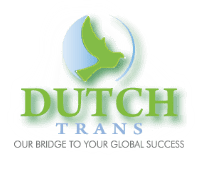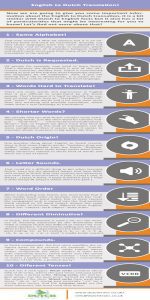
English to Dutch Translation: a fun infographic to review!
06 Feb English to Dutch Translation: a fun infographic to review!
English to Dutch translation services offer a gateway to seamless communication between speakers of both languages. With the assistance of advanced technology and professional translators, accurate translations are achieved, ensuring that the essence of the original text is preserved. Whether it’s translating documents, audio files, or even colloquial language, these services provide high-quality translations that cater to various needs.
From document translation to voice input and speech technology, the range of translation methods and tools available ensures accessibility and efficiency. With context-aware English-Dutch translations and corpus-informed dictionaries, translations are not only accurate but also natural-sounding. The use of translation apps and advanced AI technologies further enhances the translation process, making it easier and more effective. Additionally, the accessibility of video content through translation applications expands the reach of content to Dutch-speaking audiences. Overall, English to Dutch translation services offer authentic, high-quality translations that facilitate cross-cultural understanding and communication.
English to Dutch translation easy to obtain? If you will collaborate with the right professionals, it can be. We can be of help! Now we are going to give you some critical information about the English to Dutch translation, it is a bit similar with Dutch to English facts, but it also has a lot of particularities that might be interesting for you to know! Let’s find out more about that!
Main English to Dutch translation facts that you should know
Same alphabet:
That may sound a little bit obvious but it a critical point and must be mentioned. Not only those languages have the same alphabet, but they have the same alphabet, but they have a lot of similar words in common, which makes the process of English to Dutch translation is much more efficiently than many other kinds of translation in the world!
Dutch is requested:
UK people, for example, may need to learn Dutch. That’s because the Netherlands is one of the UK’s closest countries. Besides that, Dutch is consistently ranked as one of the top five most frequently requested languages by UK employers. Also, if you are looking for a life in the Netherlands, it is easier to understand the culture if you learn the local language.
Words hard to translate:
There are some words and expressions in English that it is difficult to understand by the Dutch people. That’s because it is hard to identify the context of some words such as: “facepalm,” “trade-off” and “spam.” These words and a lot more have more than one meaning and possible translations, which makes them a real challenge to translate! English to Dutch translations can turn out quite challenging. However, with the help of certificate translation services it will be much easier to get the results desired.
Tired of reading? How about saving our infographic for later use? Download the image from here.
Shorter words: another English to Dutch translation fact
One fascinating aspect of English to Dutch translation is the consideration of shorter words. In English, words tend to be longer compared to their Dutch counterparts due to differences in linguistic structures. When translating, this poses a challenge as Dutch often employs shorter words to convey the same meaning.
Professional translators, armed with translation software and dictionaries, navigate this discrepancy adeptly to ensure accurate and fluent translations. While machine translation solutions like Google Translator offer instant translations, they may struggle with preserving the concise nature of Dutch language. This is where human translation shines, with translators meticulously selecting shorter Dutch equivalents without sacrificing meaning or clarity. By embracing the efficiency of shorter words, English to Dutch translation achieves seamless communication, catering to both languages’ linguistic nuances and preferences.
We already told you that Dutch contains some extremely long words, just like their words for Chronic Fatigue Syndrome: chronischevermoeidheidssyndroom. But, in English, we don’t have that kind of word commonly, so this kind of translation can be more complicated than it seems when it comes to translating whose sentences in big words like that.
Dutch origin:
Dutch origin plays a significant role in the world of translation and linguistics, especially within the Indo-European language family. Professional Dutch translators are essential for providing accurate and culturally relevant translations for Dutch speakers. Whether dealing with technical translations or certified translations, human translation ensures that the correct translations adhere to the grammatical rules and cultural nuances of the target language. Dutch translation agencies utilize a combination of human intervention and artificial intelligence to deliver excellent quality translations.
Tools like the Dutch translator tool and Dutch-English dictionary, including online dictionaries and dictionary entries, aid in providing precise translations. These resources are invaluable for translating between language pairs such as English-Dutch and German-Dutch, ensuring that both the literal translation and the context are preserved.
This is particularly important for federal governments, government agencies, and official documents in Latin America, South Africa, and Caribbean islands, where Dutch may be used alongside other languages. The use of English loan-words and the need for accurate English word-order make human intervention crucial for maintaining the accuracy of translations. Companies like Language Scientific emphasize the importance of manual translation to ensure comfort and correctness in translations. Overall, the combination of professional Dutch translators and advanced translation tools supports the production of high-quality translations that respect the cultural and linguistic heritage of the Dutch language.
Dutch origin holds a significant place in linguistic history, tracing its roots back to the Germanic language family. With its rich heritage and cultural influence, Dutch has evolved into a distinct language spoken by millions worldwide. Translating its nuances and complexities requires advanced translation tools and methods, ranging from machine translation solutions like Google Translator to manual translation by human translators.
The accuracy and quality of translations are paramount, especially when dealing with sensitive content or domain-specific features. Cambridge’s corpus-informed translation dictionaries contribute to maintaining translation quality by providing context-aware translations. Whether it’s audio translation or speech technology, the advancement of translation applications ensures that original voice tracks and file types are seamlessly translated. From standard translation services to art translation services, the versatility of translation methods caters to diverse needs and preferences. Overall, Dutch origin remains a cornerstone of linguistic diversity, driving innovation and cultural exchange in the global landscape.
One positive thing about English to Dutch translations is that some English words: “bamboo, drug, and waffle” came originally from the Dutch: “Bamboe drogue, wafel” which make things easier when translating sentences related to these kinds of words and there are a lot of them! A professional translation agency could really make things much easier when it comes to English to Dutch translation.


Letter sounds:
That could be a difficult thing to get when learning Dutch. Here are the alphabet letters that have different sound in Dutch that may confuse you whenever you hear their pronunciation: A (ah), C(say), G (khay), J (yay), K(kah), P (pay), Q (kew), R (air), T (tay), U (ew), V (vay), W (way), X (eeks) and Y (ee-grek).
Word order:
For English to Dutch translations, you must know that it has similar word order to German. Dutch has “subject- object- verb” word order, but in main clauses, the conjugated verb is moved into the 2nd position (verb second or V2 word order), almost the same word order of German, but different from English, which has “subject-verb-object” word order.
These are a few points that we thought we would share with our friends who are translating from Dutch to English. For translation services, call now!
These are a few fun English to Dutch translation facts for you to review and enjoy. We are here for all of your translation needs!


